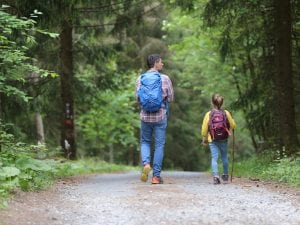
Written By Marissa DiBella
Connecticut offers a wealth of outdoor spaces from city parks to rural area trail systems where people can engage in all types of activities such as hiking, biking, and nature watching while adhering to social distancing guidelines. Spending time outdoors is a great way to get exercise, reduce stress, and can be a good educational experience for kids of all ages. Additionally, doing activities outside can increase happiness and wellbeing.
For new trail users, heading onto the trails can seem a bit overwhelming as it can be hard to know what to expect on the trails. Information about what to pack, eat, and how to navigate trail systems is not always widely available. This is why we have launched a new video series called “Trails 101” on our Connecticut Trails webpage. This series of four videos explains to trail users everything they need to know before stepping onto the trails. The videos cover topics such as how to prepare for a hike, what to bring, trail etiquette, and the leave no trace principles. Trail users of all levels have a responsibility to know how to respect themselves, others, and the environment when heading out into nature. These videos provide the tools needed for a successful adventure on Connecticut trails.
Other resources available for new trail users include websites such as AllTrails.com. AllTrails is a great resource to help people locate hikes in their area. On AllTrails, trails can be sorted by difficulty level, length, and type of trail. There is information about features of the trail such as vistas and waterfalls, and accessibility of the trails. The hikes are posted by community members and do not always include all information available so cross checking with trail managing organizations would also be helpful. The benefit of AllTrails being a crowd-sourced website is that other trail users can leave reviews of the hike and the current conditions to help others decide if the trail is right for them at that time.
Another online resource for finding trails is the Connecticut Forest and Park Association Interactive Map. This map helps hikers find blue blazed trails near them. The website includes an informational video on how to use the interactive map which we would highly recommend watching as it shows just how helpful this interactive map can be.
As helpful as all these online resources can be, sometimes, the best option is a paper map. Paper maps can be printed from the internet, purchased from the organization that maintains the trail of interest, or, sometimes, found for free at trailhead information huts. Since cell service is not always available and cell phones can run out of battery, it’s always good to be prepared by having a paper trail map.
A final resource trail users should explore before heading outside is the Leave No Trace website which provides information on how to be a responsible trail user. On the website, they discuss the 7 principles of Leave No Trace (LNT). These principles outline ways humans can make the least amount of impact on the environment when visiting natural places. We all live in the same environment, so it is the job of everyone to help preserve it. These principles are not hard to follow yet they have a huge impact on preserving our wild places. For example, the LNT principles of disposing of waste properly and traveling on durable surfaces are small actions trail users can take to maintain the beauty of the natural environments we all enjoy recreating in.
After watching the Trails 101 video series, looking at websites like AllTrails.com, and reviewing the LNT principles, it’s time to hit the trail, get some exercise and enjoy the great outdoors. Enjoy exploring all Connecticut has to offer.